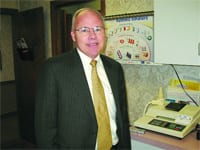On the Beam Messages Steel the Hearts of Children’s Hospital Patients
Betsy Arseneau says it all started with a few large signs created by some patients and staff in Baystate Children’s Hospital and intended for workers putting up the $239 million Hospital of the Future just a few yards away.
“They said, ‘hello down there from the kids up here,’” said Arseneau, a child-life specialist at the hospital, who noted that back when the signs were made, in August, the new hospital was nothing more than a giant hole in the ground, and the construction crews were truly down there!
Now, children staying at the hospital are looking up at the ironworkers, who are currently toiling on what will be the structure’s seventh floor. But when they look out the windows, they’re seeing more than hard-hat-wearing men and women and the giant cranes that are visible from miles away.
They’re also seeing their names and some well-wishes spray-painted onto the steel beams forming the new hospital’s skeleton. One in large, bold letters says simply, “Emily, Get Well!”
There are now several dozen names appearing on beams across many floors. There are, for example, Austin, Taylor, Kenneth, Sierra, Alyssa … and, in bright orange, ‘Chi Chi.’
That’s the nickname that Lenisha Morales, an 11-year-old leukemia patient, has had for several years now. She’s been in and out of the children’s hospital several times since being diagnosed in August, and during one stay in early November, she was summoned to a window, from which she could see her name prominently displayed across a horizontal beam.
“It was really cool seeing it there,” she told The Healthcare News while preparing to head back home after a recent week-long stay that was part and parcel to her ongoing treatment regimen. “I looked, and there it was. It made that day much brighter.”
That’s the general idea behind the beam-painting exploits, said Jimmy Trinchini, union steward for Ironworkers Local 7, which represents employees with Daniel Marr & Sons in South Boston, the subcontractor handling the steel erection on the project.
Not long after work began on the massive undertaking, the ironworkers, noting the close proximity of their work to the children’s wing, realized that they had an opportunity to perhaps lift the spirits of children who find themselves in the hospital.
Regularly, Arseneau provides job foremen with the names of recently admitted children, said Trinchini, adding that crew members then go about customizing those beams they know the young patients will be able to see out their windows.
“There’s a little bit of pressure involved,” he said with a laugh. “We have to make sure there’s no mistakes and that we spell everyone’s names right. It’s been fun for the kids, but it also gives us a break from the pressure we’re under. We get to give the kids a smile … and that’s a great reward.”
What’s in a Name?
When asked for a general job description for a child-life specialist, Arseneau said that it centers around providing support to patients and their families, and it comes in a number of ways, from procedural to bereavement. They also perform a variety of daily duties, including what she called “therapeutic play” with children on the 50-bed wing.
“We do a lot of work with chronic patients,” she said, referring to children, like Chi Chi, who spend significant amounts of time in the hospital, and also those in the so-called PICU, or pediatric intensive-care unit.
The ongoing work on the Hospital of the Future has provided some new wrinkles in the day-to-day work of child-life specialists, Arseneau explained. For starters, the general construction work and the constant turning of the giant cranes, whose cabs are some 200 feet off the ground, have become a source of entertainment and fascination for children who often find themselves bored by the confines of a hospital room.
“Sometimes they’ll sit for hours and watch,” she said. “It takes them away from the monotony of being here, and it can take them away from the pain they might be feeling. It really is a cool experience to see this building taking shape.”
Not as cool, though, as seeing your name in bright yellow, green, or blue paint on one of the beams, she continued, adding that the practice — similar in some ways to the well-documented beam-painting work at the Dana Farber Cancer Institute during one of its recent expansions — started several months ago, at that point when the new building approached the height of the children’s floor and patients could see the names out the windows facing north.
These include those in most of the rooms of the PICU, she explained, adding that this is where the sickest patients on the floor stay. And the names of many these individuals now grace the south façade.
But while some patients are in the children’s hospital for stays that could last weeks or even months, most are in are for just a few days, said Arseneau, adding that this puts a little more pressure on the ironworkers to keep up with the volume of new names on the beams.
“They do a great job, though” she continued. “There are new names being added on a regular basis — almost every day.”
Getting the Message
Trinchini told The Healthcare News that crews still have at least a few months of steel-hanging work to do. Certainly by early spring the beams will be covered with fireproofing material and eventually bricks.
The children’s names will be gone, he said, but they certainly won’t be forgotten, and neither will their ability to brighten the days of both those who wrote the notes and those who read them from their hospital beds.




Comments are closed.